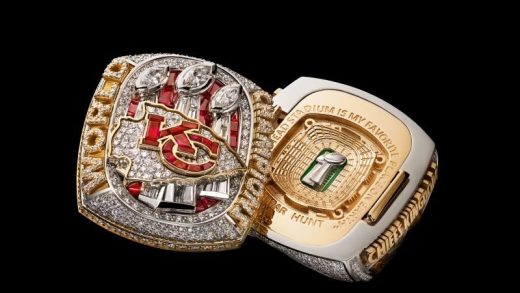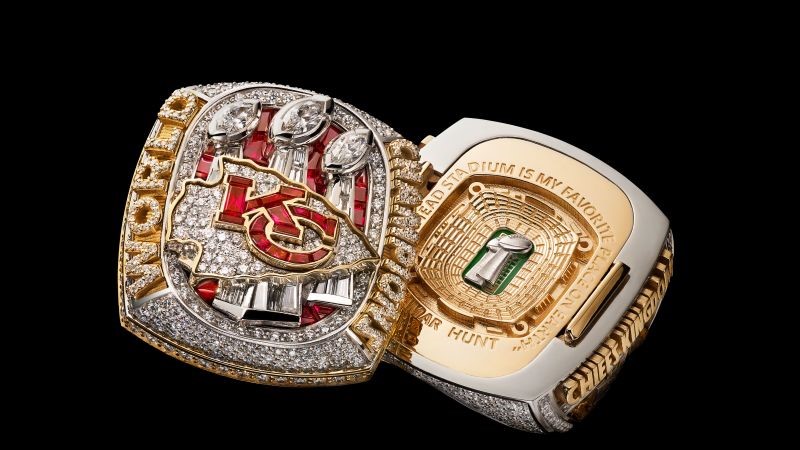12 things you don’t know about the Super Bowl ring
By Paul Mueller
When you hold a Super Bowl ring for the first time, it’s not the blinding bling or the colossal size that captures your attention. It’s the weight. Modern Super Bowl rings can weigh more than a quarter of a pound—which may not sound like much, but when it’s hugging your ring finger, you feel every gram.
Super Bowl ring design has grown increasingly elaborate and gaudy, each ring’s aesthetic more extravagant than the last. The weeks-long design process begins before the game even kicks off. Each year, once a winner is declared, jewelers “bid” for the honor of designing the championship ring. The day after the Super Bowl, in what’s a reality show waiting to happen, jewelers present their designs to the team, hoping to be chosen for the project. Once a jeweler is selected, the design phase takes roughly eight weeks, and once finalized, production takes four to six weeks.
Custom ring maker Jostens is behind 37 of the 57 Super Bowl rings to date, including the first in 1967, and the one that commemorated the Kansas City Chiefs’ win over the Philadelphia Eagles in 2020. Other designers have included Balfour and Tiffany & Co., the latter of which also designed the Vince Lombardi Trophy, named for the legendary football coach and awarded annually to the Super Bowl champs (the company makes one each year from scratch).
Celebrity-favorite jeweler Jason Arasheben, owner of Jason of Beverly Hills, won bids to design the Tampa Bay Buccaneers’ rings in 2021 and the Los Angeles Rams’ in 2022, having previously designed championship rings for the L.A. Lakers and Golden State Warriors of the NBA, among others.
From what they’re made of to what they’re worth to why Vladimir Putin has one, here are 12 other facts and statistics about the NFL’s title rings to help you claim your own Super Bowl trivia game championship.
Where it all started: The tradition of awarding rings to championship teams began in baseball when the New York Giants won the 1922 World Series against the crosstown-rival Yankees. The players chose rings over previous awards like lapel pins and engraved pocket watches.
Bling, bling: The first Super Bowl rings were awarded to the Green Bay Packers, winners of Super Bowl I in 1967. Each was designed by coach Lombardi alongside Jostens and featured a single diamond. The most recent ring, awarded to the Chiefs in 2023 and also designed by Jostens, features 613 diamonds totaling 16.1 carats. It also has 35 genuine custom-cut rubies.
What they’re made of: The only NFL requirement for the rings is that the Super Bowl logo be incorporated into the design. The rings are typically made of yellow or rose gold; the 2010 Packers broke tradition, opting for theirs to be set in platinum.
They’re not free: The cost per Super Bowl ring can run anywhere from $30,000 to $50,000. The New England Patriots’ Super Bowl XLIX rings, for instance, cost $36,500 each. A full set of rings for a team can cost upwards of $5 million.
Who pays for them: The NFL contributes $5,000 per ring for the first 150 rings. The team finances any additional rings. Chiefs players reportedly paid $11,000 for their 2023 Super Bowl rings, which was deducted from their paychecks—a minor concession considering each player on the winning team received a $157,000 bonus. (This year’s winners will receive a $164,000 pay bump.)
(Almost) everybody gets one: Every player on the 53-man roster receives a personalized Super Bowl ring featuring their name and jersey number. Coaches, executives, and other key team employees also receive rings, although some employees—including practice squad players—often receive a less-valuable version. Each year, anywhere from 300 to 900 rings are produced, depending on the size of the organization and how many the owners decide to give away.
The losers get rings too: No, not a Super Bowl ring—but the losing team still receives a ring to commemorate their conference championship, though they’re not nearly as extravagant. For instance, the ring the Cincinnati Bengals received after losing Super Bowl LVI looks like this.
Putin has one: In 2005, Patriots owner Robert Kraft was part of a group that visited the Russian president in an effort to “stimulate commerce” between his nation and the United States. According to Kraft, he showed Putin his Super Bowl XXXIX ring, and as he placed it on the president’s finger, Putin said, “I could kill someone with this ring.” Kraft extended his hand for Putin to return it, and, according to Kraft, Putin instead put the ring in his pocket and walked away. Later, the Bush administration allegedly instructed Kraft to say he “gifted” the ring to Putin, claiming that it “would be in the country’s best interest.” Putin has denied stealing the ring.
The king of champions: Former Patriots head coach Bill Belichick won six Super Bowls in New England. However, his boat is named “VIII Rings.” What gives? Belichick won two titles with the Giants as defensive coordinator, bringing his total to eight Super Bowl rings, the most ever (and one more than former star quarterback Tom Brady’s seven).
There’s a bustling aftermarket: In 2012, Giants legend Lawrence Taylor’s Super Bowl XXV ring was auctioned off for $230,401, still the auction record for a player’s ring. The overall record goes to Kraft’s Super Bowl LI ring, which he auctioned off for charity in 2020; it sold for a little over $1 million. Another Patriots Super Bowl LI ring sold for $344,927 in 2018—this one, with the name “Brady” on it. No, it wasn’t Tom’s. It was a smaller “friends and family” version of the one the GOAT received. Both the buyer and seller were anonymous. Multiple past Super Bowl rings, including some made for individual players, are currently for sale.
The rings have an economic impact and create jobs: The production of Super Bowl rings by Jostens at its Denton County, Texas, facility generates $2.1 million in economic output locally, $1.4 million for the rest of Texas, and $1.1 million nationally, according to Jenny Thorvaldson, chief economist and data officer at IMPLAN, an economic impact data provider. IMPLAN estimates that 53 Jostens employees participate directly in the production of the rings over a four-month period, supporting 22 additional jobs nationwide through supply chains and household spending.
The biggest ring, ever: Super Bowl rings are already big. But the largest ever made was in 1985 for a member of the Chicago Bears, William “the Refrigerator” Perry. The ring size for the average adult male is between 10 and 12. Perry’s was a massive 25, big enough to fit a silver dollar through.
Every Super Bowl ring has a story, and the designs reflect that. The Patriots’ Super Bowl LI rings featured 283 diamonds, which is not a random number—it reflects the 28 to 3 deficit the team overcame to beat the Atlanta Falcons, the largest comeback in Super Bowl history. The following year, when the Patriots fell to the Eagles in Super Bowl LVII, the Eagles’ rings featured 127 diamonds on the bezel alone. Again, not a random number, but the aggregate of the jersey numbers of the three players who executed the “Philly Special,” a now-iconic trick play that gave the Eagles a two-score halftime lead en route to an upset win.
When the San Francisco 49ers face the Chiefs on Sunday, one team will come out victorious, and there will surely be a new story to tell about the championship ring designed for them.
(12)



